-
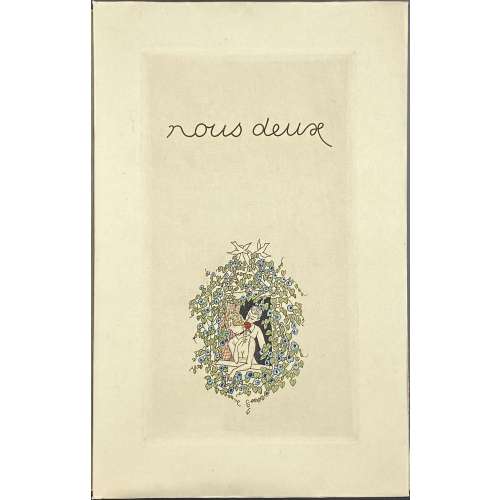 Description: Two volumes 23.1 x 14.9 cm each, collated in 4to, uniformly bound in French flapped wrappers with the title and an engraved vignette, coloured; wrapped in glassine; cased in a cardboard chemise (23.1 x 15 cm) with a diaper of two hearts pierced by an arrow, in pink; and both volumes cased in a slipcase (23.8 x 15.2 cm) with the same diaper. Printed on unpaginated dense wove paper watermarked ‘Arches’, engravings with clear plate marks. Illustrations are by Jean Dulac. Title-page (double-fillet frame, black and red in manuscript) Nelly et Jean | – | nous deux | simples | papiers | du| tiroir secret | {vignette} | Première partie (Deuxième partie) | – | Gravé | et imprimé | pour les auteurs | et leurs amis || Vol. 1: 1 blank, π4 (blank, h.t., frontis., engr. t.p.), 1-84, [2 blanks]; total 39 leaves with 19 hand-coloured burin engravings, incl. wrapper, frontis., and t.p. Unpag. Vol. 2: 1 blank, π4 (blank, h.t., frontis., engr. t.p.), 1-114, [1 colophon] [2 blanks], total 52 leaves with 27 hand-coloured burin engravings, incl. wrapper, frontis., and t.p. Unpag. Limitation: total print run of 295 copies of which 12 (№№ 1-12) on Japon Impérial, 13 on Vélin d’Arches (№№ 13-25), 30 on Japon Impérial (№№ 26-55) and 240 on Vélin d’Arches (№№ 56-295); this is copy № 97 on Vélin d’Arches. Contributors: Marcel Valotaire (French, 1889 – 1979) – author. Jean Dulac (French, 1902 – 1968) – artist. Printed by Coulouma (Argenteuil) and Vernant (Paris). The same title with illustrations by Gaston de Sainte-Croix was published in 1956: LIB-2880.2021.
Description: Two volumes 23.1 x 14.9 cm each, collated in 4to, uniformly bound in French flapped wrappers with the title and an engraved vignette, coloured; wrapped in glassine; cased in a cardboard chemise (23.1 x 15 cm) with a diaper of two hearts pierced by an arrow, in pink; and both volumes cased in a slipcase (23.8 x 15.2 cm) with the same diaper. Printed on unpaginated dense wove paper watermarked ‘Arches’, engravings with clear plate marks. Illustrations are by Jean Dulac. Title-page (double-fillet frame, black and red in manuscript) Nelly et Jean | – | nous deux | simples | papiers | du| tiroir secret | {vignette} | Première partie (Deuxième partie) | – | Gravé | et imprimé | pour les auteurs | et leurs amis || Vol. 1: 1 blank, π4 (blank, h.t., frontis., engr. t.p.), 1-84, [2 blanks]; total 39 leaves with 19 hand-coloured burin engravings, incl. wrapper, frontis., and t.p. Unpag. Vol. 2: 1 blank, π4 (blank, h.t., frontis., engr. t.p.), 1-114, [1 colophon] [2 blanks], total 52 leaves with 27 hand-coloured burin engravings, incl. wrapper, frontis., and t.p. Unpag. Limitation: total print run of 295 copies of which 12 (№№ 1-12) on Japon Impérial, 13 on Vélin d’Arches (№№ 13-25), 30 on Japon Impérial (№№ 26-55) and 240 on Vélin d’Arches (№№ 56-295); this is copy № 97 on Vélin d’Arches. Contributors: Marcel Valotaire (French, 1889 – 1979) – author. Jean Dulac (French, 1902 – 1968) – artist. Printed by Coulouma (Argenteuil) and Vernant (Paris). The same title with illustrations by Gaston de Sainte-Croix was published in 1956: LIB-2880.2021. -
 Hardcover volume from the series Masterworks of ukiyo-e, 26.1 x 19 cm, bound in canvas, red characters on black strip to front, red and black lettering to spine, tan embossed endpapers, in a pictorial slipcase with series design (black lettering on silver spine); pp: [1-6]: h.t./frontis. (colour plate pasted in), t.p./imprint, contents/acknowledgements), 7-16 text, 17-96 (79 plates w/captions). Title-page (in frame): MASTERWORKS OF UKIYO-E | HOKUSAI | SKETCHES AND PAINTINGS | by Muneshige Narazaki | English adaptation by John Bester | {publisher’s device} | KODANSHA INTERNATIONAL LTD. | Tokyo, Japan & Palo-Alto, Calif., U.S.A | {vertical, between rules 漫画肉筆画} || Series: Masterworks of ukiyo-e, № 7. Muneshige Narazaki [楢崎 宗重] (Japanese, 1904 – 2001) – author. Katsushika Hokusai [葛飾 北斎] (Japanese, 1760 – 1849) – artist. John Bester (British, 1927 – 2010) – adaptation.
Hardcover volume from the series Masterworks of ukiyo-e, 26.1 x 19 cm, bound in canvas, red characters on black strip to front, red and black lettering to spine, tan embossed endpapers, in a pictorial slipcase with series design (black lettering on silver spine); pp: [1-6]: h.t./frontis. (colour plate pasted in), t.p./imprint, contents/acknowledgements), 7-16 text, 17-96 (79 plates w/captions). Title-page (in frame): MASTERWORKS OF UKIYO-E | HOKUSAI | SKETCHES AND PAINTINGS | by Muneshige Narazaki | English adaptation by John Bester | {publisher’s device} | KODANSHA INTERNATIONAL LTD. | Tokyo, Japan & Palo-Alto, Calif., U.S.A | {vertical, between rules 漫画肉筆画} || Series: Masterworks of ukiyo-e, № 7. Muneshige Narazaki [楢崎 宗重] (Japanese, 1904 – 2001) – author. Katsushika Hokusai [葛飾 北斎] (Japanese, 1760 – 1849) – artist. John Bester (British, 1927 – 2010) – adaptation. -
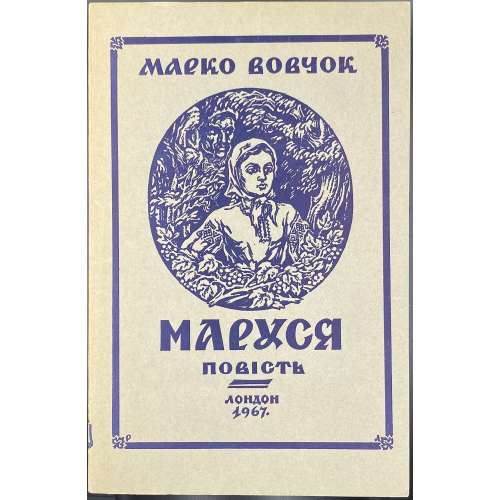 Paperback, 21.3 x 14 cm, original grey wrappers, vignette and lettering in frame, lettering to spine, publisher’s device to back, all in blue; pp.: [1-4] 5-112. Title-page: МАРКО ВОВЧОК | МАРУСЯ | ПОВIСТЬ | {fleuron} | ВИДАННЯ | СОЮЗУ УКРАÏНЦIВ У ВЕЛИКIЙ БРИТАНIÏ | ЛОНДОН 1967 || Title-page verso: “MARUSIA” | by | MARKO VOVCHOK | NOVEL IN UKRAINIAN LANGUAGE | — | REPRINT | — | Republished by | ASSOCIATION OF UKRAINIANS IN GREAT BRITAIN LTD. | (PUBLISHING DEPARTMENT) | {four lines of text in double-rules} | Printed in the United Kingdom for Association of Ukrainians | in Great Britain Ltd. by | Ukrainian Publishers Limited, 200 Liverpool Rd., London, N. 1. || The French version of the Ukrainian name Маруся —> MAROUSSIA. The French version of the book: LIB-2674.2021; another copy of the Ukrainian edition (1943): LIB-3136.2023. Other variants of the author's name Марко Вовчок: Markowovzok and Marko Vovtchok. Contributors: Марко Вовчок [Marko Vovchok; Марія Олександрівна Вілінська] (Ukrainian, 1833 – 1907) – author. Василь Миколайович Доманицький [Василий Николаевич Доманицкий; Vasyl Domanytskyi] (1877 – 1910) – translator from Russian to Ukrainian. Святомир Фостун (Ukrainian, 1924 – 2004) – foreword.
Paperback, 21.3 x 14 cm, original grey wrappers, vignette and lettering in frame, lettering to spine, publisher’s device to back, all in blue; pp.: [1-4] 5-112. Title-page: МАРКО ВОВЧОК | МАРУСЯ | ПОВIСТЬ | {fleuron} | ВИДАННЯ | СОЮЗУ УКРАÏНЦIВ У ВЕЛИКIЙ БРИТАНIÏ | ЛОНДОН 1967 || Title-page verso: “MARUSIA” | by | MARKO VOVCHOK | NOVEL IN UKRAINIAN LANGUAGE | — | REPRINT | — | Republished by | ASSOCIATION OF UKRAINIANS IN GREAT BRITAIN LTD. | (PUBLISHING DEPARTMENT) | {four lines of text in double-rules} | Printed in the United Kingdom for Association of Ukrainians | in Great Britain Ltd. by | Ukrainian Publishers Limited, 200 Liverpool Rd., London, N. 1. || The French version of the Ukrainian name Маруся —> MAROUSSIA. The French version of the book: LIB-2674.2021; another copy of the Ukrainian edition (1943): LIB-3136.2023. Other variants of the author's name Марко Вовчок: Markowovzok and Marko Vovtchok. Contributors: Марко Вовчок [Marko Vovchok; Марія Олександрівна Вілінська] (Ukrainian, 1833 – 1907) – author. Василь Миколайович Доманицький [Василий Николаевич Доманицкий; Vasyl Domanytskyi] (1877 – 1910) – translator from Russian to Ukrainian. Святомир Фостун (Ukrainian, 1924 – 2004) – foreword. -
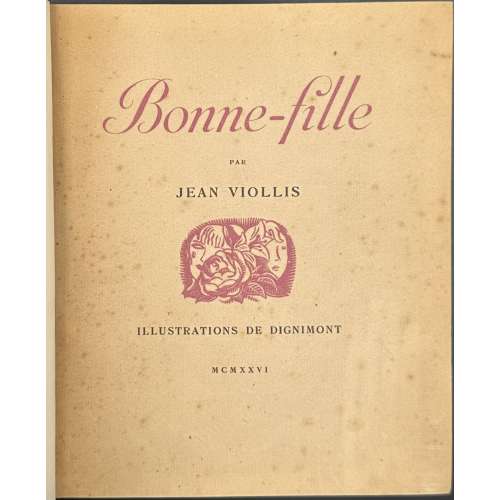 Hardcover volume, 22.5 x 19.5 cm, collated 4to, owner’s terracotta cloth with gilt-lettered black label to spine, publisher’s wrappers preserved, pp.:3 ffl, front wrapper, 3 ffl, [2] h.t./limit, [2] t.p./blank, 1-228 [2] 3 ffl, back wrapper, 3 ffl. Collation: π3 1-314 323. (130 leaves, incl. plates). Title-page (pink and black): Bonne-fille | PAR | JEAN VIOLLIS | Illustrations de | DIGNIMONT | {vignette} | A PARIS | La Collection Originale | ÉDITIONS MORNAY | 37, BOULEVARD DU MONTPARNASSE | MCMXXVI || Illustrations: 14 full-page colour plates, incl. frontispiece and endpiece, within collation but not within pagination, verso blank, and numerous head- and tailpieces and in-text stencil-coloured (au pochoir) lithography after André Dignimont. Limitation: A print run of 628 copies for sale, of which 18 on Japon Ancien, 30 on Japon Impérial, 90 on Hollande, 490 on Rives (139-628), plus 50 copies not for sale. Printed on May 12, 1926, at l’Imprimerie Kapp (Vanves), this copy is № 380. Provenance: Feodor Rojankovsky, pictorial bookplate “ИЗ КНИГ РОЖАНКОВСКАГО” to front pastedown, ms inscription to front ffl2 top “TH. ROJANKOWSKY | 14 VIII 30” in block letters. One of the possible transliterations of Feodor Rojankovsky's name is Theodor Rojankowsky. Contributors: Jean-Henri d'Ardenne deTizac [JeanViollis] (French, 1877 – 1932) – author. André Dignimont (French, 1891 – 1965) – artist. Frédéric Emile Kapp (French, 1851-193?) – printer. Georges Mornay (French, 1876 – 1935) et Antoinette Mornay – pubishers. Feodor Rojankovsky [Rojan; Фёдор Степанович Рожанковский] (Russian-American, 1891 – 1970) – provenance.
Hardcover volume, 22.5 x 19.5 cm, collated 4to, owner’s terracotta cloth with gilt-lettered black label to spine, publisher’s wrappers preserved, pp.:3 ffl, front wrapper, 3 ffl, [2] h.t./limit, [2] t.p./blank, 1-228 [2] 3 ffl, back wrapper, 3 ffl. Collation: π3 1-314 323. (130 leaves, incl. plates). Title-page (pink and black): Bonne-fille | PAR | JEAN VIOLLIS | Illustrations de | DIGNIMONT | {vignette} | A PARIS | La Collection Originale | ÉDITIONS MORNAY | 37, BOULEVARD DU MONTPARNASSE | MCMXXVI || Illustrations: 14 full-page colour plates, incl. frontispiece and endpiece, within collation but not within pagination, verso blank, and numerous head- and tailpieces and in-text stencil-coloured (au pochoir) lithography after André Dignimont. Limitation: A print run of 628 copies for sale, of which 18 on Japon Ancien, 30 on Japon Impérial, 90 on Hollande, 490 on Rives (139-628), plus 50 copies not for sale. Printed on May 12, 1926, at l’Imprimerie Kapp (Vanves), this copy is № 380. Provenance: Feodor Rojankovsky, pictorial bookplate “ИЗ КНИГ РОЖАНКОВСКАГО” to front pastedown, ms inscription to front ffl2 top “TH. ROJANKOWSKY | 14 VIII 30” in block letters. One of the possible transliterations of Feodor Rojankovsky's name is Theodor Rojankowsky. Contributors: Jean-Henri d'Ardenne deTizac [JeanViollis] (French, 1877 – 1932) – author. André Dignimont (French, 1891 – 1965) – artist. Frédéric Emile Kapp (French, 1851-193?) – printer. Georges Mornay (French, 1876 – 1935) et Antoinette Mornay – pubishers. Feodor Rojankovsky [Rojan; Фёдор Степанович Рожанковский] (Russian-American, 1891 – 1970) – provenance. -
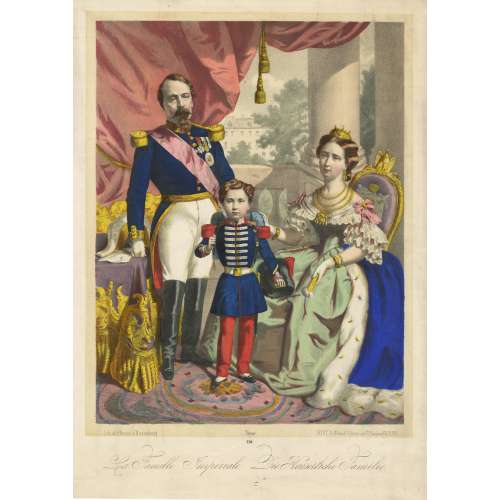 Hand-coloured lithography on wove paper, 395 x 280 mm; black ink stamp “5309” to reverse. On image: artist's initials "L. H."; on stone: "Lith. de Fr. Wentzel a Wissembourg. — Déposé — DÉPÔT, Fr. Wentzel Editeur rue St. Jacques 65, PARIS"; below centre: "239"; bottom : La famille Impériale. Die Kaizerliche Familie. Napoleon III [Charles-Louis Napoléon Bonaparte] (French, 1808 – 1873) Eugénie de Montijo [L'impératrice Eugénie] (Spanish-French, 1826 – 1920) Napoléon, Prince Imperial (Napoléon Eugène Louis Jean Joseph Bonaparte] (French, 1856 – 1879) Jean Frédéric Wentzel (French, 1807 – 1869) – publisher/printer.
Hand-coloured lithography on wove paper, 395 x 280 mm; black ink stamp “5309” to reverse. On image: artist's initials "L. H."; on stone: "Lith. de Fr. Wentzel a Wissembourg. — Déposé — DÉPÔT, Fr. Wentzel Editeur rue St. Jacques 65, PARIS"; below centre: "239"; bottom : La famille Impériale. Die Kaizerliche Familie. Napoleon III [Charles-Louis Napoléon Bonaparte] (French, 1808 – 1873) Eugénie de Montijo [L'impératrice Eugénie] (Spanish-French, 1826 – 1920) Napoléon, Prince Imperial (Napoléon Eugène Louis Jean Joseph Bonaparte] (French, 1856 – 1879) Jean Frédéric Wentzel (French, 1807 – 1869) – publisher/printer. -
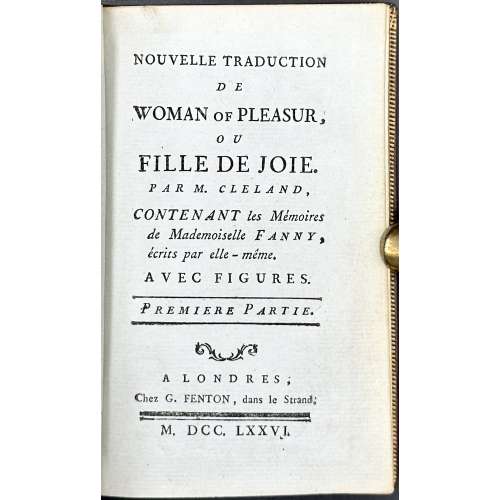 Hardcover volume, collated 18mo, 130 x 85 mm (2 parts in one). Contemporary burgundy morocco outlined with gilt triple fillet, flat spine gilt in compartments, brown morocco label gilt, all edges gilt, gilt dentelle, text printed on slightly blue laid paper with illegible watermark; dark blue endpapers, Tony Fekete (T. F.) bookplate by Wahorn to front pastedown. Frontispiece and 14 engraved plates by Elluin after Borel, with guard tissue. Graphite ms to h.t.: "Figures de Borrel. | Gravées pr. Elluin." Title-page: NOUVELLE TRADUCTION | DE | WOMAN OF PLEASUR, | OU | FILLE DE JOIE. | PAR M. CLELAND, | CONTENANT les Mémoires | de Mademoiselle FANNY, | écrits par elle – même. | AVEC FIGURES | — | PREMIERE (SECONDE) PARTIE. | — | ~ | A LONDRES; | Chez G. FENTON, dans le Strand; | — | M. DCC. LXXVI. || Collation: 18mo throughout A-O12/6, total 126 leaves plus 15 plates, incl. frontispiece. Pagination: separate for each part [1-5] 6-119 [120 blank], [1-3] 4-132, total 252 pages. Provenance: Tony Fekete (Christie’s 2014, № 54, p. 37; Price realized GBP 11,875): “[CLELAND, John (1709-1789).] Nouvelle traduction de Woman of Pleasur [sic] ou Fille de Joie. Contenant les Mémoires de Mademoiselle Fanny, écrits par elle-même. London [but Paris]: G. Fenton [Cazin], 1776. 2 volumes in one, duodecimo (128 x 80 mm). Printed on blue tinted paper. Frontispiece and 14 engraved plates on thick white paper by Elluin after Borel. (Short tear repaired in the margin of one plate, another plate with a faint dampstain touching the facing leaf of text.) Contemporary burgundy morocco, flat spine gilt in compartments, morocco label gilt, covers with a gilt triple fillet border, gilt edges, blue endpapers. THE MOST BEAUTIFUL 18TH-CENTURY ILLUSTRATED EDITION OF THIS CELEBRATED EROTIC NOVEL. An excellent copy bound in contemporary morocco. It is the second translation into French, but the first to include the exquisite plates by Elluin after Borel. These are some of the best illustrations by this remarkable partnership responsible for a number of important 18th-century libertine texts. Cohen-DeRicci 242-3; Dutel A-407 ; Gay-Lemonnyer II, 304; Pia Enfer, 915.” Catalogue raisonné: Dutel (I) A-407, p. 134; Cohen-DeRicci 242-3; Fekete (Christie's) 54, p. 37. Contributors: John Cleland (British, c. 1709 – 1789). François-Rolland Elluin (French, 1745 – c. 1822) Antoine Borel (French, 1743 – 1810) Hubert-Martin Cazin (French, 1724 – 1795) András Wahorn (Hungarian, b. 1953) Fekete, Tony Laszlo (Hungarian, b. 1972)
Hardcover volume, collated 18mo, 130 x 85 mm (2 parts in one). Contemporary burgundy morocco outlined with gilt triple fillet, flat spine gilt in compartments, brown morocco label gilt, all edges gilt, gilt dentelle, text printed on slightly blue laid paper with illegible watermark; dark blue endpapers, Tony Fekete (T. F.) bookplate by Wahorn to front pastedown. Frontispiece and 14 engraved plates by Elluin after Borel, with guard tissue. Graphite ms to h.t.: "Figures de Borrel. | Gravées pr. Elluin." Title-page: NOUVELLE TRADUCTION | DE | WOMAN OF PLEASUR, | OU | FILLE DE JOIE. | PAR M. CLELAND, | CONTENANT les Mémoires | de Mademoiselle FANNY, | écrits par elle – même. | AVEC FIGURES | — | PREMIERE (SECONDE) PARTIE. | — | ~ | A LONDRES; | Chez G. FENTON, dans le Strand; | — | M. DCC. LXXVI. || Collation: 18mo throughout A-O12/6, total 126 leaves plus 15 plates, incl. frontispiece. Pagination: separate for each part [1-5] 6-119 [120 blank], [1-3] 4-132, total 252 pages. Provenance: Tony Fekete (Christie’s 2014, № 54, p. 37; Price realized GBP 11,875): “[CLELAND, John (1709-1789).] Nouvelle traduction de Woman of Pleasur [sic] ou Fille de Joie. Contenant les Mémoires de Mademoiselle Fanny, écrits par elle-même. London [but Paris]: G. Fenton [Cazin], 1776. 2 volumes in one, duodecimo (128 x 80 mm). Printed on blue tinted paper. Frontispiece and 14 engraved plates on thick white paper by Elluin after Borel. (Short tear repaired in the margin of one plate, another plate with a faint dampstain touching the facing leaf of text.) Contemporary burgundy morocco, flat spine gilt in compartments, morocco label gilt, covers with a gilt triple fillet border, gilt edges, blue endpapers. THE MOST BEAUTIFUL 18TH-CENTURY ILLUSTRATED EDITION OF THIS CELEBRATED EROTIC NOVEL. An excellent copy bound in contemporary morocco. It is the second translation into French, but the first to include the exquisite plates by Elluin after Borel. These are some of the best illustrations by this remarkable partnership responsible for a number of important 18th-century libertine texts. Cohen-DeRicci 242-3; Dutel A-407 ; Gay-Lemonnyer II, 304; Pia Enfer, 915.” Catalogue raisonné: Dutel (I) A-407, p. 134; Cohen-DeRicci 242-3; Fekete (Christie's) 54, p. 37. Contributors: John Cleland (British, c. 1709 – 1789). François-Rolland Elluin (French, 1745 – c. 1822) Antoine Borel (French, 1743 – 1810) Hubert-Martin Cazin (French, 1724 – 1795) András Wahorn (Hungarian, b. 1953) Fekete, Tony Laszlo (Hungarian, b. 1972) -
 Artist: Utagawa Kuniyoshi [歌川 國芳] (1798 – 1861). Kabuki actors Ichikawa Danjūrō VIII and Arashi Rikan III as sumo wrestlers Nuregami Chōgorō (L) and Hanaregoma Chōkichi (R), respectively. Signed: Ichiyûsai Kuniyoshi ga (一勇斎 國芳 画) in a double gourd-shaped cartouche with Yoshi Kiri seal. Publisher: No seal. Date seal and double nanushi censor seal: Mera & Watanabe, 1852. Media: Fan print (uchiwa-e, 団扇絵), 231 x 295 mm. Theme: Nine-act drama (11 scenes) Futatsu Chōchō Kuruwa Nikki [双蝶々曲輪日記] (A Diary of Two Butterflies in the Pleasure Quarters) written by Takeda Izumo II, Namiki Senryū I, Miyoshi Shōraku (7/1749) as puppet play Bunraku [文楽], adopted for Kabuki theatre by Arashi San'emon IV. “The sumo wrestler Nuregami Chōgorō is trying to ransom the courtesan Azuma for Yogoro, in whose debt he stands. Hiraoka Goemon, who is at odds with Yogorō and Azuma, is the patron of the amateur wrestler Hanaregoma Chōkichi. Chōgorō purposely loses to Chōkichi and then asks the latter to stop Goemon's ransoming of Azuma; Chōkichi refuses, however, and they quarrel. Admonished for his dissipation by his sister Oseki, Chōkichi is going to commit ritual suicide (seppuku) as an apology for his behavior, but Chōgorō, who happens along just then, prevents him. The two men swear blood brotherhood. […] The confrontation between Chōgorō and Chōkichi in the Sumōba scene, acted in the exaggerated style called aragoto, is a major highlight of the work. The scene in Yohei's home, known as Hikimado, presents the unfolding of Kabuki's eternal conflict between duty and feelings, here represented by the act of opening the skylight (hikimado) to which Chōgorō is tied”. [Samuel L. Leiter. Kabuki Encyclopedia: an English-language adaptation of Kabuki Jiten. — Westport, CT; London: Greenwood Press, 1979, pp. 70-71]. See also James R. Brandon and Samuel L. Leiter. Kabuki plays on stage, vol. 1, pp. 234-258. — Honolulu: University of Hawai'i Press, 2002. Actors: Ichikawa Danjūrō VIII [市川団十郎] (Japanese, 1823 – 1854); other names: Ichikawa Ebizō VI, Ichikawa Shinnosuke II. Arashi Rikan III [嵐璃寛] (Japanese, 1812 – 1863); other names Arashi Tokusaburō III, Arashi Kicchō I, Onoe Wasaburō I. Another print in this collection with the same theme: SVJP-0331.2020.
Artist: Utagawa Kuniyoshi [歌川 國芳] (1798 – 1861). Kabuki actors Ichikawa Danjūrō VIII and Arashi Rikan III as sumo wrestlers Nuregami Chōgorō (L) and Hanaregoma Chōkichi (R), respectively. Signed: Ichiyûsai Kuniyoshi ga (一勇斎 國芳 画) in a double gourd-shaped cartouche with Yoshi Kiri seal. Publisher: No seal. Date seal and double nanushi censor seal: Mera & Watanabe, 1852. Media: Fan print (uchiwa-e, 団扇絵), 231 x 295 mm. Theme: Nine-act drama (11 scenes) Futatsu Chōchō Kuruwa Nikki [双蝶々曲輪日記] (A Diary of Two Butterflies in the Pleasure Quarters) written by Takeda Izumo II, Namiki Senryū I, Miyoshi Shōraku (7/1749) as puppet play Bunraku [文楽], adopted for Kabuki theatre by Arashi San'emon IV. “The sumo wrestler Nuregami Chōgorō is trying to ransom the courtesan Azuma for Yogoro, in whose debt he stands. Hiraoka Goemon, who is at odds with Yogorō and Azuma, is the patron of the amateur wrestler Hanaregoma Chōkichi. Chōgorō purposely loses to Chōkichi and then asks the latter to stop Goemon's ransoming of Azuma; Chōkichi refuses, however, and they quarrel. Admonished for his dissipation by his sister Oseki, Chōkichi is going to commit ritual suicide (seppuku) as an apology for his behavior, but Chōgorō, who happens along just then, prevents him. The two men swear blood brotherhood. […] The confrontation between Chōgorō and Chōkichi in the Sumōba scene, acted in the exaggerated style called aragoto, is a major highlight of the work. The scene in Yohei's home, known as Hikimado, presents the unfolding of Kabuki's eternal conflict between duty and feelings, here represented by the act of opening the skylight (hikimado) to which Chōgorō is tied”. [Samuel L. Leiter. Kabuki Encyclopedia: an English-language adaptation of Kabuki Jiten. — Westport, CT; London: Greenwood Press, 1979, pp. 70-71]. See also James R. Brandon and Samuel L. Leiter. Kabuki plays on stage, vol. 1, pp. 234-258. — Honolulu: University of Hawai'i Press, 2002. Actors: Ichikawa Danjūrō VIII [市川団十郎] (Japanese, 1823 – 1854); other names: Ichikawa Ebizō VI, Ichikawa Shinnosuke II. Arashi Rikan III [嵐璃寛] (Japanese, 1812 – 1863); other names Arashi Tokusaburō III, Arashi Kicchō I, Onoe Wasaburō I. Another print in this collection with the same theme: SVJP-0331.2020. Reference images:
Reference images:
-
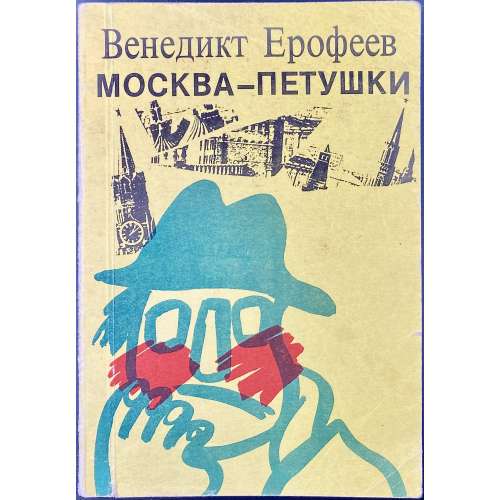 Paperback, 17.2 x 12 cm, yellow pictorial wrappers, lettering to front, back, and spine; pp.: [1-4] 5-137 [5]. Title-page: ВЕНЕДИКТ | ЕРОФЕЕВ | МОСКВА — ПЕТУШКИ | ПОВЕСТЬ | Таллинн | “Александра” | 1990 || Print-run: 30,000. Contributors: Венедикт Васильевич Ерофеев [Venedikt Yerofeyev] (Russian, 1938 – 1990) – author.
Paperback, 17.2 x 12 cm, yellow pictorial wrappers, lettering to front, back, and spine; pp.: [1-4] 5-137 [5]. Title-page: ВЕНЕДИКТ | ЕРОФЕЕВ | МОСКВА — ПЕТУШКИ | ПОВЕСТЬ | Таллинн | “Александра” | 1990 || Print-run: 30,000. Contributors: Венедикт Васильевич Ерофеев [Venedikt Yerofeyev] (Russian, 1938 – 1990) – author. -
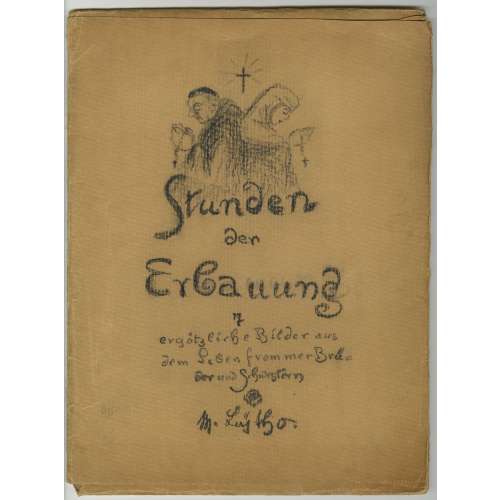 Flapped folder of thick embossed paper 353 x 263 mm, with a vignette and manuscript to front: Stunden der Erbauung | 7 | ergötz liebe Bilder aus | dem Leben frommer Brü | der und Schwestern | • | M. Leÿtho. ||, six graphite pencil drawings, each glued to a paper sheet with guard tissue; mat size 339 x 253 mm mat; drawing size 220 x 165 mm. Translation of the title: Hours of Edification / 7 delightful pictures from the lives of pious brothers and sisters. Information about the artist at www.honesterotica.com: "Mitja Leytho, almost certainly a pseudonym, is yet another mediocre yet fascinating amateur artist from the Germany of the 1920s about whom we know absolutely nothing beyond the four portfolios which bear the ‘Leytho’ signature".
Flapped folder of thick embossed paper 353 x 263 mm, with a vignette and manuscript to front: Stunden der Erbauung | 7 | ergötz liebe Bilder aus | dem Leben frommer Brü | der und Schwestern | • | M. Leÿtho. ||, six graphite pencil drawings, each glued to a paper sheet with guard tissue; mat size 339 x 253 mm mat; drawing size 220 x 165 mm. Translation of the title: Hours of Edification / 7 delightful pictures from the lives of pious brothers and sisters. Information about the artist at www.honesterotica.com: "Mitja Leytho, almost certainly a pseudonym, is yet another mediocre yet fascinating amateur artist from the Germany of the 1920s about whom we know absolutely nothing beyond the four portfolios which bear the ‘Leytho’ signature". -
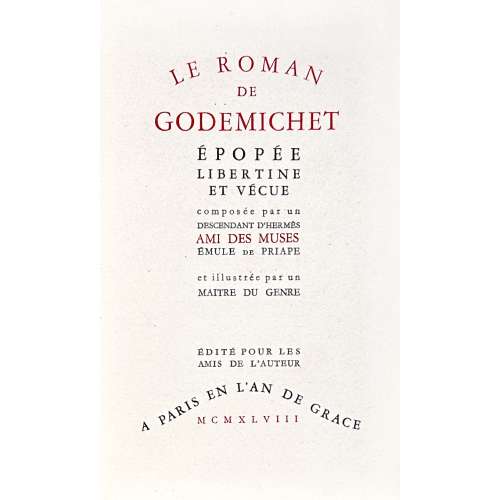 Softcover volume, 23.5 x 15 cm, in tan French flapped wrappers with red lettering to front, collated in-4to, in a tan double slipcase 24 x 15 cm with red lettered label to spine, pp.: [1-12] 13-112 [8], total 120 pages, incl. those within wrappers; printed on thick wove paper watermarked “Lafuma Frères”, 5 full-page and 6 half-page illustrations within collation, incl. frontispiece, guard tissue laid in. Title-page (red and black): LE ROMAN | DE | GODEMICHET | ÉPOPÉE | LIBERTINE | ET VÉCUE | composée par un | DESCENDANT D’HERMES | AMI DES MUSES | ÉMULE DE PRIAPE | et illustrée par un | MAITRE DU GENRE | ÉDITÉ POUR LES | AMIS DE L’AUTEUR | A PARIS EN L’AN DE GRACE | MCMXLVIII || Limited edition 200 + XX, this is copy № 175. Catalogue raisonné: Dutel III № 2336. Jean Reschofsky (French, 1905 – 1998) – artist.
Softcover volume, 23.5 x 15 cm, in tan French flapped wrappers with red lettering to front, collated in-4to, in a tan double slipcase 24 x 15 cm with red lettered label to spine, pp.: [1-12] 13-112 [8], total 120 pages, incl. those within wrappers; printed on thick wove paper watermarked “Lafuma Frères”, 5 full-page and 6 half-page illustrations within collation, incl. frontispiece, guard tissue laid in. Title-page (red and black): LE ROMAN | DE | GODEMICHET | ÉPOPÉE | LIBERTINE | ET VÉCUE | composée par un | DESCENDANT D’HERMES | AMI DES MUSES | ÉMULE DE PRIAPE | et illustrée par un | MAITRE DU GENRE | ÉDITÉ POUR LES | AMIS DE L’AUTEUR | A PARIS EN L’AN DE GRACE | MCMXLVIII || Limited edition 200 + XX, this is copy № 175. Catalogue raisonné: Dutel III № 2336. Jean Reschofsky (French, 1905 – 1998) – artist. -
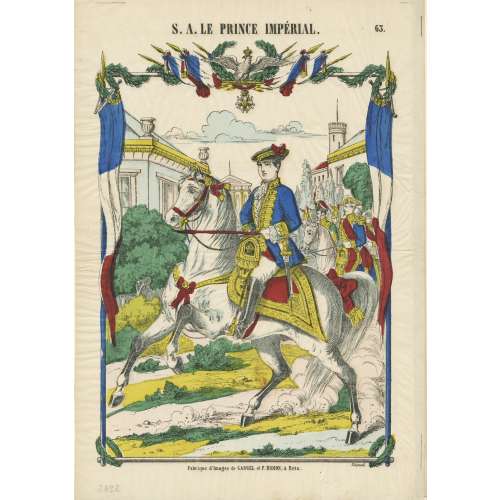 Hand-coloured woodcut on wove paper, 327 x 280 mm; black ink stamp “5265” to reverse, attached to the sheet 470 x 325 mm. Top centre: "S. A. LE PRINCE IMPÉRIAL.", right: "63." Image: equestiral portrait of Prince Impérial. Under the image, centre: "Fabrique d'Images de GANGEL et P. DIDION, à Metz." — "Déposé." Napoléon, Prince Imperial (Napoléon Eugène Louis Jean Joseph Bonaparte] (French, 1856 – 1879). Gangel et P. Didion (Metz); Paulin Didion (French, 1831 – 1879) – publisher/printer.
Hand-coloured woodcut on wove paper, 327 x 280 mm; black ink stamp “5265” to reverse, attached to the sheet 470 x 325 mm. Top centre: "S. A. LE PRINCE IMPÉRIAL.", right: "63." Image: equestiral portrait of Prince Impérial. Under the image, centre: "Fabrique d'Images de GANGEL et P. DIDION, à Metz." — "Déposé." Napoléon, Prince Imperial (Napoléon Eugène Louis Jean Joseph Bonaparte] (French, 1856 – 1879). Gangel et P. Didion (Metz); Paulin Didion (French, 1831 – 1879) – publisher/printer. -
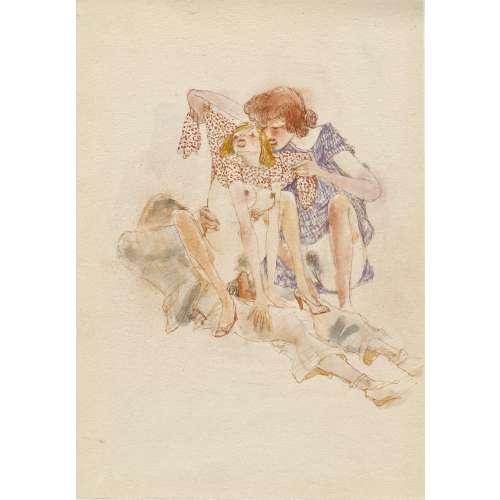 Watercolour on thick wove paper, unsigned. Attributed to Otto Rudolf Schatz (Austrian, 1900 – 1961). Size: 305 x 212 mm.
Watercolour on thick wove paper, unsigned. Attributed to Otto Rudolf Schatz (Austrian, 1900 – 1961). Size: 305 x 212 mm. -
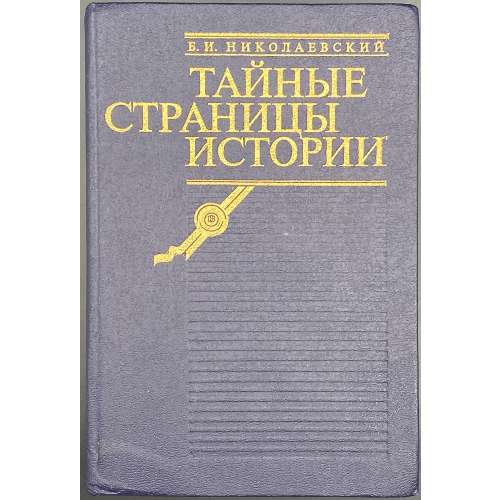 Hardcover volume, 22.2 x 15 cm, bound in blind-stamped blue buckram with gilt lettering to front cover and spine, pp.: [1-4] h.t., t.p., 5-507 [508] [4] contents/colophon, advert.; collated in 16mo (1-1616), 256 leaves, 512 pages. Title-page: Б. И. НИКОЛАЕВСКИЙ | ТАЙНЫЕ | СТРАНИЦЫ | ИСТОРИИ | ЛЕНИН И ДЕНЬГИ / БОЛЬШЕВИСТСКОЙ ОРГАНИЗАЦИИ | БИОГРАФИЯ МАЛЕНКОВА | ГЕРМАНИЯ / И РУССКИЕ РЕВОЛЮЦИОНЕРЫ / В ГОДЫ ПЕРВОЙ МИРОВОЙ / ВОЙНЫ | ПРОТОКОЛЫ ПОЛИТБЮРО / И ДОКУМЕНТЫ ОСОБОГО ОТДЕЛА / НКИД СССР, 1934 | Москва | Издательство | гуманитарной литературы | 1995 || Print run: 2,000 copies. Contributors: Борис Иванович Николаевский [Boris Nicolaevsky] (Russian-American, 1887 – 1966) – author. Юрий Георгиевич Фельштинский [Yuri Felshtinsky] (Jewish-Russian-American, b. 1956) – editor/compiler. ISBN: 5-87121-007-4. History's secret pages.
Hardcover volume, 22.2 x 15 cm, bound in blind-stamped blue buckram with gilt lettering to front cover and spine, pp.: [1-4] h.t., t.p., 5-507 [508] [4] contents/colophon, advert.; collated in 16mo (1-1616), 256 leaves, 512 pages. Title-page: Б. И. НИКОЛАЕВСКИЙ | ТАЙНЫЕ | СТРАНИЦЫ | ИСТОРИИ | ЛЕНИН И ДЕНЬГИ / БОЛЬШЕВИСТСКОЙ ОРГАНИЗАЦИИ | БИОГРАФИЯ МАЛЕНКОВА | ГЕРМАНИЯ / И РУССКИЕ РЕВОЛЮЦИОНЕРЫ / В ГОДЫ ПЕРВОЙ МИРОВОЙ / ВОЙНЫ | ПРОТОКОЛЫ ПОЛИТБЮРО / И ДОКУМЕНТЫ ОСОБОГО ОТДЕЛА / НКИД СССР, 1934 | Москва | Издательство | гуманитарной литературы | 1995 || Print run: 2,000 copies. Contributors: Борис Иванович Николаевский [Boris Nicolaevsky] (Russian-American, 1887 – 1966) – author. Юрий Георгиевич Фельштинский [Yuri Felshtinsky] (Jewish-Russian-American, b. 1956) – editor/compiler. ISBN: 5-87121-007-4. History's secret pages. -
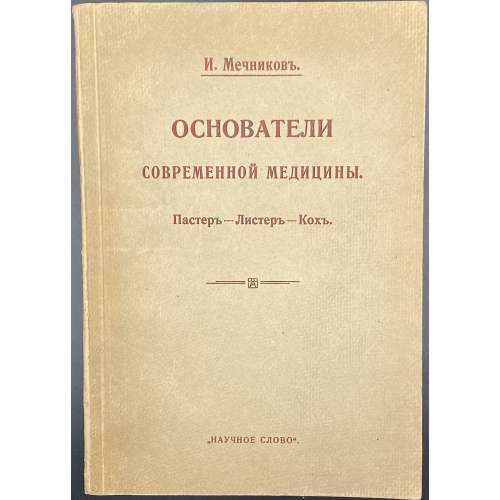 Paperback, 22.3 x 15.5 cm, publisher’s tan wrappers, brown lettering to front and spine, imprint and price to back, pp.: [1-3] 4-136 [2] blank/advert.; collated 8vo: [1]-88, 94 χ1, total 69 leaves plus 6 photomechanical plates, incl. frontispiece, four of them portraits. Title-page: И. Мечниковъ | ОСНОВАТЕЛИ | СОВРЕМЕННОЙ МЕДИЦИНЫ. | Пастеръ. — Листеръ. — Кохъ. | — | Изданiе | “НАУЧНАГО СЛОВА”. | Москва — 1915. Contributors and Characters: Илья Ильич Мечников [Élie Metchnikoff] (Russian, 1845 – 1916) – author. "Научное слово" – publisher. Типо-литография Товарищества И. Н. Кушнерев и Ко. — printer. Louis Pasteur (French, 1822 – 1895) – character. Joseph Lister (British, 1827 – 1912) – character. Robert Koch (German, 1843 – 1910) – character.
Paperback, 22.3 x 15.5 cm, publisher’s tan wrappers, brown lettering to front and spine, imprint and price to back, pp.: [1-3] 4-136 [2] blank/advert.; collated 8vo: [1]-88, 94 χ1, total 69 leaves plus 6 photomechanical plates, incl. frontispiece, four of them portraits. Title-page: И. Мечниковъ | ОСНОВАТЕЛИ | СОВРЕМЕННОЙ МЕДИЦИНЫ. | Пастеръ. — Листеръ. — Кохъ. | — | Изданiе | “НАУЧНАГО СЛОВА”. | Москва — 1915. Contributors and Characters: Илья Ильич Мечников [Élie Metchnikoff] (Russian, 1845 – 1916) – author. "Научное слово" – publisher. Типо-литография Товарищества И. Н. Кушнерев и Ко. — printer. Louis Pasteur (French, 1822 – 1895) – character. Joseph Lister (British, 1827 – 1912) – character. Robert Koch (German, 1843 – 1910) – character. -
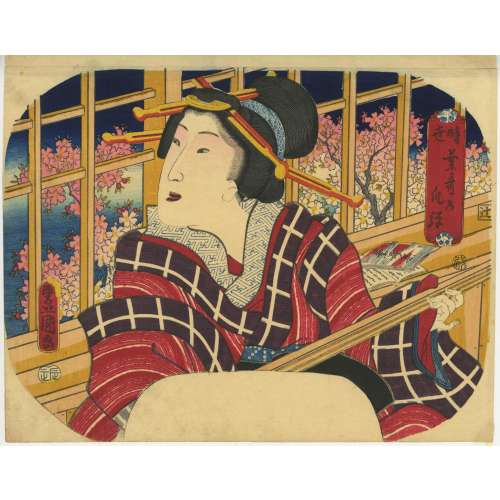 Artist: Utagawa Kunisada [歌川 国貞], a.k.a. Utagawa Toyokuni III [三代 歌川 豊国] (Japanese, 1786 – 1865). Signed: Toyokuni ga [豊国 画] in a red toshidama cartouche Publisher: Iseya Ichiemon [伊勢屋市右衛門] (Japanese, fl. c. 1820s – c. 1860s); seal Tsuji [辻] (Marks 16-029). Media: Untrimmed fan print (uchiwa-e), 225 x 295 mm, plus 10 mm paper strip glued on top (235 mm total height). Title: Plucking Popular Songs in Those Days [時世葉歌の爪弾] (Imayo ha-uta no tsuma-biki). Date seal and aratame seal: Ansei 3 (1856). Seller's Description: Uchiwa-e; picture intended for a summer fan. Here we see a relaxed beauty wearing loose layers of kimono and playing her shamisen instrument. She appears to be in the happy mood of spring, her singing inspired by the cherry blossoms in full bloom that we see outside of her window. She enjoys leisurely plucking with the plectrum of the shamisen and singing “ha-uta” (popular) songs. The title Ha-uta [葉歌] is normally written 端歌, which indicates a certain category of popular songs accompanied by shamisen with short texts that are drawn from daily life. Here however, the title葉歌 uses phonetically the same “ha葉“, referring to the title of the book of a collection of ha-uta songs, Matsu no ha [松の], which was published in five volumes in 1703 by Shûshôken 秀松軒. It is said that this collection of songs was written and sung by the blind (who were often musicians by livelihood). Behind her, lying on the window sill, we see two ha-uta songbooks, one open and one closed. The last half of the title tsuma-biki [爪弾] translates “to pluck with fingers” instead of a plectrum, which is the usual way of playing the shamisen.
Artist: Utagawa Kunisada [歌川 国貞], a.k.a. Utagawa Toyokuni III [三代 歌川 豊国] (Japanese, 1786 – 1865). Signed: Toyokuni ga [豊国 画] in a red toshidama cartouche Publisher: Iseya Ichiemon [伊勢屋市右衛門] (Japanese, fl. c. 1820s – c. 1860s); seal Tsuji [辻] (Marks 16-029). Media: Untrimmed fan print (uchiwa-e), 225 x 295 mm, plus 10 mm paper strip glued on top (235 mm total height). Title: Plucking Popular Songs in Those Days [時世葉歌の爪弾] (Imayo ha-uta no tsuma-biki). Date seal and aratame seal: Ansei 3 (1856). Seller's Description: Uchiwa-e; picture intended for a summer fan. Here we see a relaxed beauty wearing loose layers of kimono and playing her shamisen instrument. She appears to be in the happy mood of spring, her singing inspired by the cherry blossoms in full bloom that we see outside of her window. She enjoys leisurely plucking with the plectrum of the shamisen and singing “ha-uta” (popular) songs. The title Ha-uta [葉歌] is normally written 端歌, which indicates a certain category of popular songs accompanied by shamisen with short texts that are drawn from daily life. Here however, the title葉歌 uses phonetically the same “ha葉“, referring to the title of the book of a collection of ha-uta songs, Matsu no ha [松の], which was published in five volumes in 1703 by Shûshôken 秀松軒. It is said that this collection of songs was written and sung by the blind (who were often musicians by livelihood). Behind her, lying on the window sill, we see two ha-uta songbooks, one open and one closed. The last half of the title tsuma-biki [爪弾] translates “to pluck with fingers” instead of a plectrum, which is the usual way of playing the shamisen. -
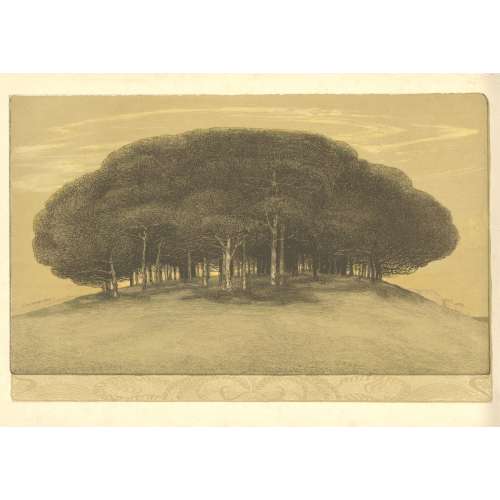 Colour (tone) lithography, image 268 x 410 mm, sheet 317 x 470 mm; signed on bottom-left of the image “Pelikan 1905”, and pencil ms inscription: E. Pelikan to the lower-right corner of the sheet. Contributor: Emilie Mediz-Pelikan (Austrian, 1861 – 1908) – artist. Seller's description: Austrian-German painter and graphic artist. Emilie Mediz-Pelikan was born in Vöcklabruck in 1861. She studied at the Vienna Academy and followed her teacher Albert Zimmermann to Salzburg and in 1885 to Munich. In 1891 she married the painter and graphic artist Karl Mediz (1868 - 1945), with whom she lived in Vienna and from 1894 in Dresden. She was in contact with the Dachau Artists' Colony and went on study trips to Paris, Belgium, Hungary and Italy. In the Dachau artists' colony she was friends with Adolf Hölzel and Fritz von Uhde. In 1889 and 1890 she spent time in Paris and in the Belgian artists' colony Knokke. In 1898 she was represented at the first art exhibition of the Vienna Secession, and in 1901 at the International Art Exhibition in Dresden. In 1903 she and her husband had a group exhibition, at the Hagenbund in Vienna. In 1904, she showed graphic works at the Dresden royal court art dealer Richter, and in 1905 and 1906 she exhibited at the Berlin Künstlerhaus. It was not until around 1900 that she achieved her artistic breakthrough with her landscape paintings. Since the estate of the artist, who died prematurely in Dresden in 1908, was lost in the former GDR until the 1980s, it was quite late that the artist was rediscovered and revalued both in Austrian art history and on the art market. In 1986, the first major exhibitions took place at the Upper Austrian State Museum and the University of Applied Arts in Vienna, followed by numerous smaller exhibitions in private galleries in Vienna, Linz and Munich. The artist received recognition during her lifetime from numerous prominent fellow painters as well as from the art critic Ludwig Hevesi. Together with Tina Blau, Herbert Boeckl, Marie Egner, Theodor von Hörmann, Franz Jaschke, Eugen Jettel, Ludwig Heinrich Jungnickel, Rudolf Junk, Gustav Klimt, Oskar Kokoschka, Johann Victor Krämer, Heinrich Kühn, Carl Moll, Rudolf Quittner, Rudolf Ribarz, Emil Jakob Schindler, Max Suppantschitsch, Max Weiler, Olga Wisinger-Florian and Alfred Zoff, she was a protagonist of the reception of Impressionism in Austria. This style went down in Austrian art history under the term "Stimmungsimpressionismus".
Colour (tone) lithography, image 268 x 410 mm, sheet 317 x 470 mm; signed on bottom-left of the image “Pelikan 1905”, and pencil ms inscription: E. Pelikan to the lower-right corner of the sheet. Contributor: Emilie Mediz-Pelikan (Austrian, 1861 – 1908) – artist. Seller's description: Austrian-German painter and graphic artist. Emilie Mediz-Pelikan was born in Vöcklabruck in 1861. She studied at the Vienna Academy and followed her teacher Albert Zimmermann to Salzburg and in 1885 to Munich. In 1891 she married the painter and graphic artist Karl Mediz (1868 - 1945), with whom she lived in Vienna and from 1894 in Dresden. She was in contact with the Dachau Artists' Colony and went on study trips to Paris, Belgium, Hungary and Italy. In the Dachau artists' colony she was friends with Adolf Hölzel and Fritz von Uhde. In 1889 and 1890 she spent time in Paris and in the Belgian artists' colony Knokke. In 1898 she was represented at the first art exhibition of the Vienna Secession, and in 1901 at the International Art Exhibition in Dresden. In 1903 she and her husband had a group exhibition, at the Hagenbund in Vienna. In 1904, she showed graphic works at the Dresden royal court art dealer Richter, and in 1905 and 1906 she exhibited at the Berlin Künstlerhaus. It was not until around 1900 that she achieved her artistic breakthrough with her landscape paintings. Since the estate of the artist, who died prematurely in Dresden in 1908, was lost in the former GDR until the 1980s, it was quite late that the artist was rediscovered and revalued both in Austrian art history and on the art market. In 1986, the first major exhibitions took place at the Upper Austrian State Museum and the University of Applied Arts in Vienna, followed by numerous smaller exhibitions in private galleries in Vienna, Linz and Munich. The artist received recognition during her lifetime from numerous prominent fellow painters as well as from the art critic Ludwig Hevesi. Together with Tina Blau, Herbert Boeckl, Marie Egner, Theodor von Hörmann, Franz Jaschke, Eugen Jettel, Ludwig Heinrich Jungnickel, Rudolf Junk, Gustav Klimt, Oskar Kokoschka, Johann Victor Krämer, Heinrich Kühn, Carl Moll, Rudolf Quittner, Rudolf Ribarz, Emil Jakob Schindler, Max Suppantschitsch, Max Weiler, Olga Wisinger-Florian and Alfred Zoff, she was a protagonist of the reception of Impressionism in Austria. This style went down in Austrian art history under the term "Stimmungsimpressionismus". -
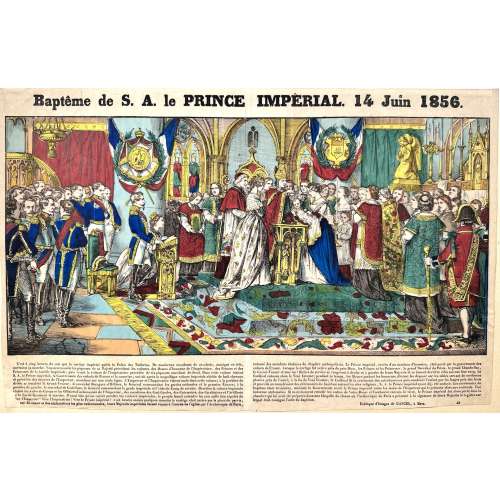 Hand-coloured woodcut on wove paper, 610 x 390 mm; black ink stamp “5207” to reverse, attached to a larger sheet of thick paper with a red ink stamp: “COLLECTION JEAN-CLAUD LACHNITT | REPRODUCTION INTERDIT”. Top: Baptême de S. A. le PRINCE IMPÉRIAL. 14 Juin 1856; image of baptism of Prince-Impérial; two-column text with a small loss in the lower left corner (C'est à cinq heures du soir que le cortège impérial quitta le Palais des Tuileries. De nombreux escadrons de cavalerie, musique en tête ouvraient la marche. ...); bottom under the text: "Fabrique d'Images de GANGEL, à Metz." — "49".
Hand-coloured woodcut on wove paper, 610 x 390 mm; black ink stamp “5207” to reverse, attached to a larger sheet of thick paper with a red ink stamp: “COLLECTION JEAN-CLAUD LACHNITT | REPRODUCTION INTERDIT”. Top: Baptême de S. A. le PRINCE IMPÉRIAL. 14 Juin 1856; image of baptism of Prince-Impérial; two-column text with a small loss in the lower left corner (C'est à cinq heures du soir que le cortège impérial quitta le Palais des Tuileries. De nombreux escadrons de cavalerie, musique en tête ouvraient la marche. ...); bottom under the text: "Fabrique d'Images de GANGEL, à Metz." — "49". -
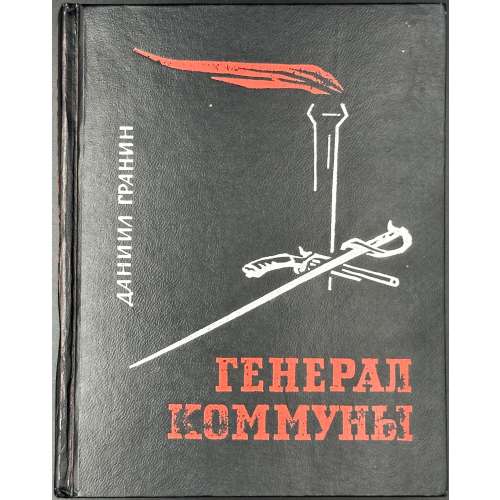 Hardcover, 17 x 13.4 cm, black buckram with red and silver vignette, lettering to front and spine, price and publisher's name embossed to back, pictorial endpapers with white lettering to red strips; pp.: [1-4] 5-268 [4], ils., collation: 16mo: 116 28 3-616 7-88 9-1016, total 136 leaves plus 3 photo plates after p. 32, 48, and 208. Frontispiece and in-text woodcuts after И. И. Старосельский. Title-page (red and black): ДАНИИЛ ГРАНИН | ГЕНЕРАЛ КОММУНЫ | (ЯРОСЛАВ ДОМБРОВСКИЙ) | — | Издательство | «СОВЕТСКАЯ РОССИЯ» | Москва — 1965 || Print run: 50,000 copies. Contributors: Даниил Александрович Гранин (Russian, 1919 – 2017) – author. Илья Израилевич Старосельский (Russian-Jewish, 1918 – 1968) – artist. Jaroslaw Dombrowski [Jarosław Dąbrowski] (Polish-French, 1836 – 1871) – character.
Hardcover, 17 x 13.4 cm, black buckram with red and silver vignette, lettering to front and spine, price and publisher's name embossed to back, pictorial endpapers with white lettering to red strips; pp.: [1-4] 5-268 [4], ils., collation: 16mo: 116 28 3-616 7-88 9-1016, total 136 leaves plus 3 photo plates after p. 32, 48, and 208. Frontispiece and in-text woodcuts after И. И. Старосельский. Title-page (red and black): ДАНИИЛ ГРАНИН | ГЕНЕРАЛ КОММУНЫ | (ЯРОСЛАВ ДОМБРОВСКИЙ) | — | Издательство | «СОВЕТСКАЯ РОССИЯ» | Москва — 1965 || Print run: 50,000 copies. Contributors: Даниил Александрович Гранин (Russian, 1919 – 2017) – author. Илья Израилевич Старосельский (Russian-Jewish, 1918 – 1968) – artist. Jaroslaw Dombrowski [Jarosław Dąbrowski] (Polish-French, 1836 – 1871) – character.




